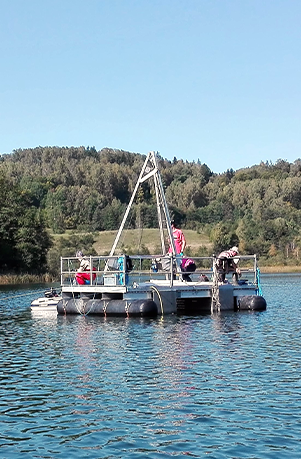The Department of Geomorphology and Quaternary Geology continues the tradition of geomorphological research in Pomerania initiated in 1959 by Professor Bolesław Augustowski. Successive heads of the geomorphological team were Professors Bogusław Rosa (1970–1996), Roman Gołębiewski (1996–2008) and Stanisław Fedorowicz (2008–2022). Research problems included geomorphological mapping of postglacial landscapes in Poland, issues related to the morphology and development of valley network of Pomerania, investigations of the sedimentary cover of the southern Baltic Sea, issues of Neopleistocene chronostratigraphy using the TL method, as well as paleogeographic studies based on palynological and diatom analyses.
Currently, the head of the Department is Professor Wojciech Tylmann. As a result of the evolution of research problems and the gradual specialization of scientists, two independent research teams have emerged in the structure of the Department: Paleoenvironmental Research Laboratory and Geomorphological Reconstructions Laboratory.
The Paleoenvironmental Research Laboratory conducts studies of past environmental changes possible to reconstruct based on lake and peat sediments. We focus on climate-related and human-related changes recorded over the last several thousand years. For correct interpretation of sediment records, a thorough knowledge about the conditions affecting sedimentation processes is necessary. That is why investigations of modern sedimentation processes in lakes are very important research theme in our laboratory. We use mainly geochronological, sedimentological and geochemical methods. Taking into account that reconstructions of environmental change are multi-disciplinary, we have close collaboration with researchers working on paleobiological proxies and stable isotopes. Our main research area is northern Poland, but we are also involved in lake sediment studies in Europe, Africa, South America, North America, Australia and Asia.

The Geomorphological Reconstruction Laboratory conducts research on past and modern geomorphological processes. The team’s main focus is on terrestrial glacial and postglacial environments, but sea coasts are also of our interest. We are also involved in research works at archaeological sites. We use innovative research methods and high-resolution spatial data to reconstruct the conditions of the landscape formation and the processes controlling its evolution. In this way, we strive to contribute to the knowledge of the rules governing natural phenomena and to its application in practice, such as protection against the effects of natural hazards. Our research includes analysis of the morphology and arrangement of landforms, recognition of structures visible in geological exposures, analysis of the petrographic, mineral and geochemical composition of sediments and their geophysical properties. We also determine the age and succession of past events using various methods of dating sediments and processes. We cooperate with many research centers in Poland and abroad. Our main research area is central and northern Europe, including the Baltic Sea, but we also participate in research on other continents.
